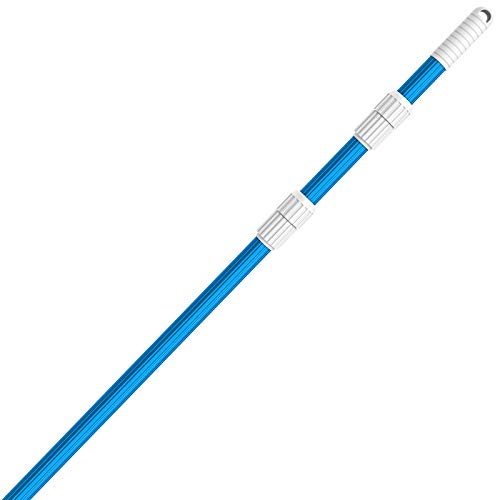Part of pool ownership is sometimes dealing with the bad stuff that might get in your water. Black algae is definitely no exception to that and can be a real pain to get rid of in your pool.
However, since you are here you are up to the challenge! Let’s further understand how black algae works and how to prevent it from getting into the pool.
What is Black Algae?
Unlike green algae and mustard algae, black algae is a bacteria that looks more blue-green when up close.
What truly separates it from its algae counterparts is instead of loosely clinging onto pool surfaces, black algae will latch onto and take a firm hold of pool walls and floor.
It is tough to remove because it can grow “roots” into the surface and form a protective barrier over itself.
Because of its porous nature, it really only affects plaster or concrete pools. Vinyl and fiberglass surfaces are too slippery for black algae to take root.
What Does Black Algae Look Like?
Black algae doesn’t really change the pool color. Instead, it almost looks like black dots that start to form on the pool’s surface.

While it is a bit difficult, they can be scraped off the pool surface. There can also be “false alarm” sightings that are metal stains instead.
A good way to tell is to scrape off a piece and place it on a napkin or paper towel. If it is dark green, then it is most likely black algae.
What Causes Black Algae to Show Up in Pools?
While it can get into the pool through airborne spores, it typically latches onto swimsuits and floaties after a trip to the lake or river. Without washing those items down before entering the pool, a red carpet has been rolled out for the black algae to enter!
However, like any water problem, the reason why it can spread is a lack of chlorine or sanitizer. A properly chlorinated pool with a weekly cleaning routine is more likely to kill these spores before they start to spread.
This is why regular pool maintenance and testing are super important!
How to Get Rid of Black Algae Spores
There is good news and bad news here.
The good news is there isn’t a requirement to shock the pool.
Unfortunately, the bad news is that it requires some hard labor, as the black algae needs to be “derooted” from the pool’s surface and severely disturbed.
This is not a single-day process, nor is it multiple days. Getting rid of black algae can take a week or longer to completely remove, depending on how much it spreads and how rooted they are.
But I know you are up to the task.
Brush, Brush, Brush. Oh Yeah, Brush Some More!
Brushing will be a large factor in how long this takes. The goal of brushing is to agitate and break the algae’s protective barrier, preventing it from forming again.
A stainless steel brush is highly recommended. If your plaster is less than a year old, switch back to a nylon brush after the algae has been killed off.
18" heavy-duty brush with stainless steel bristles for harder pool surfaces.
Test the Pool
Run a set of tests with your pool testing kit to get an accurate readout of the current chemistry parameters.
The most accurate and reliable pool testing kit.
Type of Chlorine Test: FAS-DPD
Read our full Taylor K-2006 Review.
Overall, We want pH levels to be around 7.2 to 7.4 to accommodate the higher-than-normal free chlorine (FC) levels. Anything above 10 ppm FC makes pH testing unreliable, so keeping it at the lower end is recommended.
Total alkalinity (TA) can affect pH balance as well, so make sure it is at a recommended level between 50 to 90 ppm (further understand TA levels).
Lastly, know your CYA level. This will determine how much chlorine you need to add to the pool during this process. The higher the CYA, the more chlorine you need.
Add Chlorine to the Pool
Liquid chlorine should be used here as it works fast and does not add anything else to the water.
Calcium hypochlorite, cal hypo for short, is also acceptable. Just remember that it will also increase calcium hardness (CH), so make sure you know CH levels to not go over recommended ranges.
When adding chlorine, you don’t have to get FC to shock levels necessarily, but we do want to maintain it somewhere in between the normal range and shock level based on your CYA:
| CYA (Stabilizer) | FC Targeted Range | FC to Shock Level |
|---|---|---|
| 20 | 3 – 5 ppm | 10 |
| 30 | 4 – 6 ppm | 12 |
| 40 | 5 – 7 ppm | 16 |
| 50 | 6 – 8 ppm | 20 |
| 60 | 7 – 9 ppm | 24 |
| 70 | 8 – 10 ppm | 28 |
| 80 | 9 – 11 ppm | 32 |
| 90 | 10 – 12 ppm | 36 |
| 100 | 11 – 13 ppm | 40 |
This level should be maintained until all remnants of the black algae are gone. This is very important; otherwise, all this work could be for nothing, and a week later, we would be starting back at square one.
To get a general idea of how much chlorine you will need, use our chlorine calculator.
Keep the Filter Running
As the chlorine starts to work and the brushing continues, the pool pump and filter should be running 24 hours a day to catch as much of the algae as possible.
Depending on the filter type, washing off the grids or backwashing may be necessary a few times during the process.
Keep Brushing!
You’ll want to brush these black spots at least two to three times daily, more if you can. Their barrier needs to be broken at all times so the chlorine can infiltrate the algae spore.
Brush the walls, ladders, light niches, steps, corners, and every inch of that surface!
Get another telescopic pole and brush and have a family member or neighbor help out. Nothing says bonding over killing some algae!
If Necessary, Rub Trichlor Tabs
After a few days or even a week, you’ll be able to clearly see whether the pool surface has improved or remained the same.
If your surface doesn’t seem to have any noticeable differences, try rubbing a trichlor puck directly onto the spots. Do this immediately after brushing so the tab is in direct contact with the algae and not the barrier.
The only reason this is more of a last resort is that the tabs directly contacting plaster surfaces can potentially remove thin layers of plaster, resulting in some permanent discolorations.
So proceed with caution and stop if you notice any differences in the surface.
Keep Brushing and Filtering
Not even going to say anything else about brushing.
Unfortunately, there is no secret formula for black algae. Sometime, the spores break easily. Other times, it takes weeks. Just be as patient as possible and keep at it.
One last reminder that maintaining FC levels is critical.
Not Done Yet
No more signs of algae? No black spots? Hooray! You did it! You are almost done. That was not fun, and hopefully, it won’t happen again.
Once it is clear that the algae spots are gone, try keeping FC at the higher end of the recommended range for at least a week or so. This all but guarantees that any spores are completely gone.
Once Finished, Clean Any Equipment That Contacted Algae
During this time of higher FC ranges, throw all the cleaning equipment you used into the shallow end for a few hours after use. This will sanitize the equipment and eliminate any algae that happened to stick to it.
Give all floaties and toys a good scrubbing with a Clorox wipe or diluted bleach cleaner. Essentially, anything that is going back in the water should be cleaned thoroughly.
Run your fountains and water features for a few hours to get the chlorine in their piping and insides.
Give your filter one last backwash and grid cleaning. For added assurance, replacing the existing grids with a new set might be a good idea.
Preventing Black Algae From Spreading in Your Pool
Promise yourself that this will not happen again! Follow some of the basic pool testing and maintenance guidelines to ensure your pool is clean and healthy at all times:
- Test your water frequently: Testing is the only way to know if there is a problem. Seeing an issue is too late. The more frequent testing is done, the more preventable a water outbreak can be.
- Maintain proper water chemistry: Make sure that all chemistry parameters are balanced and at the recommended levels. Water should never be unbalanced.
- Keep the water circulating: Run your filter and pump as long as possible. Not everyone has the luxury of running their equipment 24 hours a day, but it should run at least 8 hours daily so water can turn over once.
- Brush and vacuum weekly: Clean water starts with a clean surface, though not as rigorous as what you just went through. Routine brushing and vacuuming will help to disturb any contaminants on the walls or floors.
Never Read This Again
Ideally, these should never have to be written. But, kudos to you for recognizing the problem and taking care of the black algae before it gets even worse.
I think it is safe to say you deserve some nice R’n’R in the pool right about now. Enjoy it!



